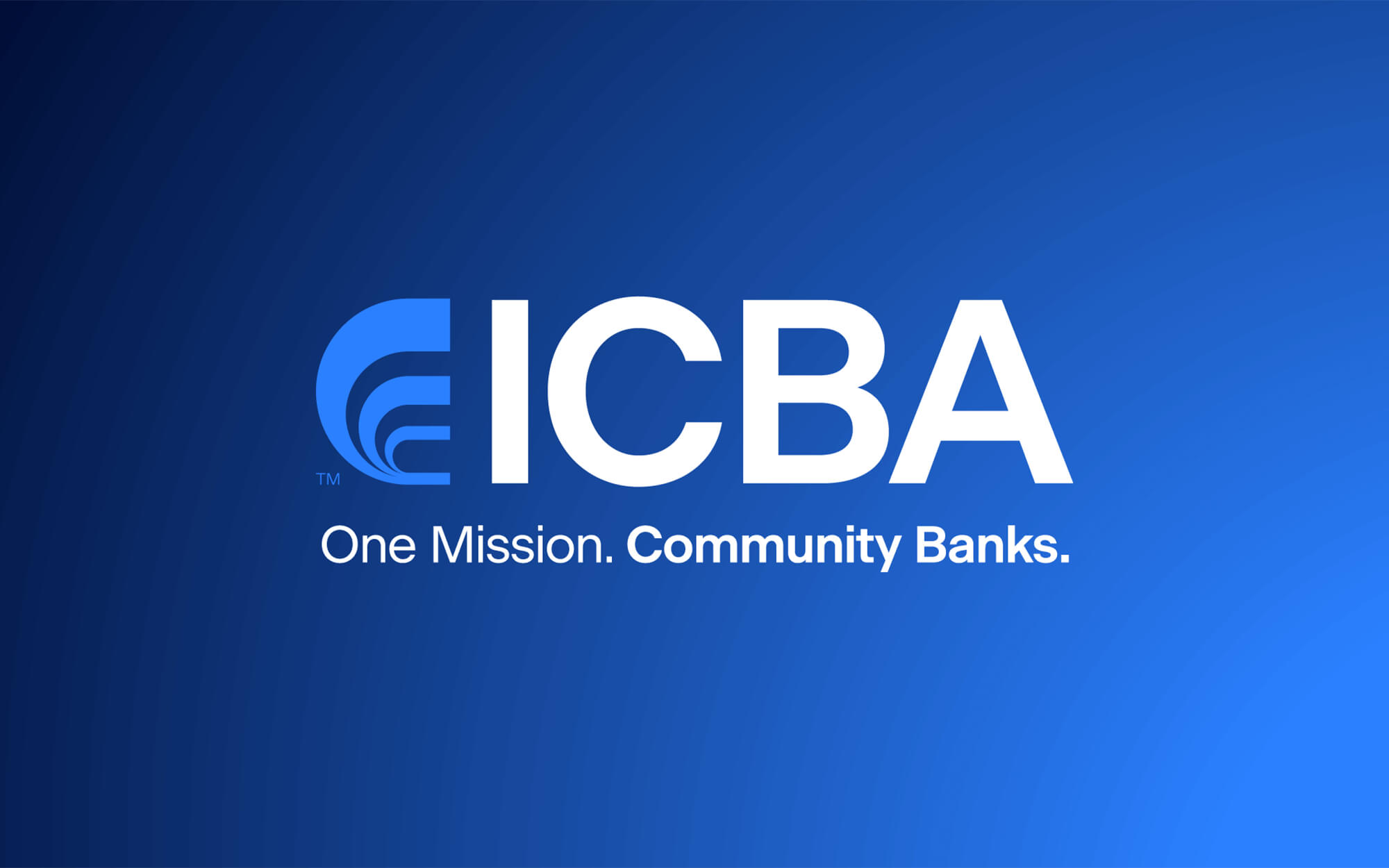Dear Mr. Delrahim,
The Independent Community Bankers of America (“ICBA”)[1] appreciates this opportunity to provide feedback to the Department of Justice’s Antitrust Division as it considers whether to revise its Bank Merger Competitive Review Guidelines.[2]
Because the competitive landscape of the banking industry has changed substantially since the guidelines were adopted in 1995, ICBA believes that it is appropriate to update the Department’s approach to reviewing bank mergers.
Background
Historically, antitrust law has been applied differently to bank mergers than to mergers in other industries. Indeed, until the Supreme Court’s decision in United States v. Philadelphia National Bank, bank mergers were considered outside the reach of review under Section 7 of the Clayton Act.
As Justice Harlan observed in his dissenting opinion in that case, “[t]he key to this case is found in the special position occupied by commercial banking in the economy of this country. With respect to both the nature of the operations performed and the degree of governmental supervision involved, it is fundamentally different from ordinary manufacturing and mercantile businesses.”[3]
ICBA does not deny the applicability of Section 7 of the Clayton Act to banking. However, we do believe that it is appropriate for the Department to be mindful of the unique nature of commercial banking and to consider the policy goal of financial stability and the role banks play in conducting the fiscal and monetary operations of the Government.
In most other businesses, entry into the market is often relatively straightforward. However, in order to engage in the business of banking, one must first receive a charter and deposit insurance. This is a natural limit on competition based on the need to ensure that depository institutions are well-managed and financially sound.
In other words, in contrast with other sectors where the anti-competitiveness of a merger is the sole basis of antitrust review, in banking, it is both prudentially appropriate and legally mandatory to consider the public interest more broadly.
In accordance with the provisions of the Bank Merger Act, “[n]o insured depository institution shall merge or consolidate with any other insured depository institution or, either directly or indirectly, acquire the assets of, or assume liability to pay any deposits made in, any other insured depository institution except with the prior written approval of the [appropriate federal banking regulator].”[4] The requirement to obtain the prior approval of federal banking regulators is unique to the banking industry.
Bank regulators may not approve a merger if its effect would be “substantially to lessen competition, or to tend to create a monopoly” unless they find that “the anticompetitive effects of the proposed transaction are clearly outweighed in the public interest by the probable effect of the transaction in meeting the convenience and needs of the community to be served.”[5]
The review of competitive factors includes a report on the competitive factors of the mergers furnished by the Attorney General. Finally, in every transaction, Federal bank regulators must consider “the financial and managerial resources and future prospects of the existing and proposed institutions, the convenience and needs of the community to be served, and the risk to the stability of the United States banking or financial system.”[6]
After the appropriate federal supervisory agency completes its review and approves a proposed transaction, it must notify the Attorney General. The Department of Justice must then decide whether to bring an action under antitrust laws within the time limits prescribed in the Bank Merger Act.[7]
The Department’s Bank Merger Competitive Guidelines
The Department of Justice’s 1995 Bank Merger Competitive Guidelines use a quantitative analysis to review the competitive effect of bank and bank holding company mergers. This analysis is conducted in a two-step process using screens (Screen A and Screen B).
Screen A is the screen most relied on by the federal banking regulators when they conduct their competitive analysis. Under Screen A, if a proposed transaction “does not result in a post-merger HHI of over 1800 and an increase of more than 200, the banking agencies are unlikely to further review the competitive effects of the merger.”[8]
The Herfindahl–Hirschman Index (HHI) is a quantitative measure designed to assess the competitiveness of a market. It is sometimes called a “sum of the squares” analysis because it is calculated by adding up the squares of the market shares of deposits of the firms within an industry in a given market. Because of the exponential nature of the HHI, it gives more weight to the competitive effect of consolidations between the firms with the largest market shares.
In cases where a bank merger exceeds the 1800/200 thresholds, banks should submit information for Screen B, which examines the HHI for each market area where the merging institutions have offices that make commercial (C&I) loans. The Department will sometimes review transactions in more detail even if they exceed neither Screen A nor Screen B. This is likely when the thresholds may not show the full effects of a transaction on lending to small businesses.
However, exceeding a screen does not automatically render a deal anticompetitive, it simply subjects the deal to further scrutiny. For example, the Department may consider, “evidence that the merging parties do not significantly compete with one another” or “evidence that a credit union has such membership restrictions, or lack of restrictions, and offers such services to commercial customers that it should be considered to be in the market.”[9]
ICBA Position
The Riegle-Neal Interstate Banking and Branching Efficiency Act established concentration limits on banking including a ten percent nationwide deposit cap as well as statewide caps of thirty percent of total deposits.[10]
ICBA strongly supports these nationwide and statewide caps as a way to ensure that the too-big-to-fail banks do not entirely dominate the banking industry. We also strongly support the national concentration limits on total consolidated liabilities that are established by Section 622 of the Dodd Frank Wall Street Reform and Consumer Protection Act.
While ICBA also supports antitrust enforcement of the banking industry by the Department of Justice, ICBA believes it is appropriate for the DOJ to modernize its Bank Merger Competitive Guidelines.
Due to the widespread adoption of online banking, mobile banking, and changes in bank (and non-bank) regulation, the competitive landscape of the industry has changed dramatically since 1995. We urge the Department to adopt Guidelines that reflect both these changes to the competitive landscape and the unique nature of the banking industry.
Guidance Generally
The Department, in its request for comment, asks, “to what extent, if at all, is it useful to have banking specific merger review guidance, beyond the 2010 Merger Review Guidelines?”[11] In ICBA’s view, it is imperative that the Department retain its practice of issuing merger guidelines specific to the banking industry. Banking is fundamentally different from ordinary manufacturing and mercantile businesses because it lies at the very heart of the financial system and the economy itself.
Due to this fact, while an analysis of the competitive effects of bank mergers is necessary and appropriate particularly where large regional or national banks are concerned, the Department should issue guidelines that also consider the broader implications of bank mergers on the financial and managerial resources of depository institutions, the effects on the overall safety and soundness of the banking system, how systemically important the merging banks are to the banking system, and on the needs and convenience of bank customers.
Specifically, the department should prioritize allowing mergers in rural and other small markets that preserve the financial viability of small banks so that these areas can continue to have a physical banking presence.
Increased regulatory burdens have forced many small banks to realize economies of scale through merger to remain economically viable. These mergers, while they may quantitatively appear anticompetitive, often result in stronger financial institutions that are better able to meet compliance burdens, deploy technology, serve local households and small business with upgraded products and services, and compete with non-local, internet-based lenders that do not have a physical presence in rural areas.
Small banks in rural markets may struggle to gain regulatory approval for mergers, and the process of seeking merger approval can drag on for over a year. By contrast, large banks are often more easily able to satisfy the quantitative anticompetitive analysis by divesting branches in certain markets.
In the first instance the merger can be thwarted even though it would result in a stronger local bank better able to serve its community and improve its service offerings. In the second instance, the bank simply divests a few branches, but the overall commercial banking system becomes more concentrated and more systemically risky.
HHI Threshold and Relevant Product and Geographic Markets
The 1800/200 HHI threshold from the 1995 merger guidelines should be retained, rather than changed to the more complicated thresholds from the general Horizontal Merger Guidelines. The purpose of an HHI screen is to identify mergers that are potentially anticompetitive so that they can be subjected to further analysis.
The 1800/200 standard is well-suited to this goal. Further complicating this threshold will not serve the Department’s purpose of “identify[ing] proposed mergers that do not have significantly adverse effects on the competition and to allow them to proceed quickly.”[12]
Furthermore, while HHI is a useful tool for quantitatively assessing market competitiveness, the extent of its usefulness is ultimately dependent on accurate market definition. If a market is defined too narrowly, either in terms of geography or relevant products/competitors, markets may appear more concentrated than they are in reality.
To account for changes in the ways that consumers and businesses borrow, the Department should update its guidelines concerning market definition to account for the ubiquitous presence of online lenders.
To reflect this new reality, the geographic markets for consumer and small business lending products should no longer be considered local. Instead, the Department should account for the presence of fintechs and online peer-to-peer lending services by examining the level of competition in these markets on a national level.
These companies are already doing business on a national level and are accessible to anyone with internet access. These lenders are currently competing with banks in both urban and rural markets, despite lacking a physical presence in their geographic market.
Non-Traditional Banks
Interested in discussing this and other topics? Network with and learn from your peers with the app designed for community bankers. Join the conversation with ICBA Community.
Historically, credit unions had tight field of membership restrictions and hard caps on member business lending that made them distinct from commercial banks. However, over time, the NCUA has significantly relaxed these restrictions.
This has led some credit unions to advertise great rates “for everyone,” illustrating how relaxed common bond restrictions have become. Because of these relaxed restrictions, credit unions now compete with community banks for deposits and across the full spectrum of lending and financial services products. This competition is fiercest in rural and smaller markets.
Currently, the Department’s bank merger guidelines only consider “evidence that a credit union has such membership restrictions, or lack of restrictions, and offers such services to commercial customers that it should be considered to be in the market” as a mitigating factor in cases where Screen B highlights a transaction for further scrutiny. [13]
We believe this approach substantially underestimates the level of competition between credit unions and community banks. Instead, it is appropriate to consider credit union competition in the same way as competition from other commercial banks – specifically by including them as “other institutions” when calculating HHI for Screens A and B.
The Department should also include online banks in its analysis of competitive effects. These institutions solicit deposits and lend on a nationwide basis and are present in urban and rural markets. As the Department observes, at present, “the geographic dispersion of deposits from online banks is not publicly available (by market or branch).”[14] However, under the Office of the Comptroller of the Currency’s (“OCC”) new Community Reinvestment Act rule, OCC-supervised banks, including internet banks, will be required to track and report the location of their retail domestic depositors.[15]
While ICBA continues to advocate for an exemption from the OCC’s deposit location reporting requirements for small community banks with a traditional business model, once this data becomes available, it will provide new insight into the competition community banks face from online banks.
We would strongly oppose any effort either from the Department or the federal banking regulators that would require additional data collection and reporting for the purposes of competitive effects analysis.
However, once the retail domestic depositor data from OCC CRA exams becomes available, that data should be considered by the Department to measure the extent to which internet banks operate in the relevant geographic markets of a proposed transaction.
Mergers in Rural Markets
When evaluating competition in rural markets, it is appropriate to consider competition from outside the confines of a narrow geography. In rural counties with relatively few banks, the most significant competitors for loans and deposits may be financial institutions in neighboring counties or in larger urban areas within driving distance. Therefore, it may be more appropriate to consider areas larger than a county as a single rural market.
The Department should set a higher HHI threshold in rural markets. In many rural counties, the number of bank and credit union branches can be counted on one hand. In these areas, HHIs will appear artificially high, particularly if a portion of the county’s residents do their banking outside the county. In rural markets HHI thresholds of 1900/250 are more appropriate to flag deals for additional scrutiny.
Finally, the Department should expand its existing consideration of loans made by the Farm Credit System (“FCS”). Community banks in rural areas are leaders in agricultural lending, accounting for over 80% of agricultural loans.
Bigger banks lack the specialized knowledge to underwrite farm loans, therefore, the FCS is the primary competitor of community banks in this market. The Department should consider the lending done by farm credit agencies in rural markets identical to agricultural loans made by other commercial banks, not just as a “mitigating factor” in deals under scrutiny.
De Minimis Exception
ICBA strongly supports the Department’s proposal to create a de minimis exception whereby the Antitrust Division “would automatically provide a report on the competitive factors of the transaction to the responsible banking agency but would not conduct an independent competitive effects analysis of these deals.”[16]
This exception is appropriate because the responsible federal banking regulator would still be required to consider the Department’s analysis to ensure that the deal does not substantially lessen competition. In this way, anticompetitive deals would still be prohibited. However, the exception would ensure that small deals could be consummated in a timely way, without protracted and costly investigations by the Department.
We believe an appropriate threshold for applying this exemption is by using the Small Business Administration’s Small Business Size Standards. The SBA considers a commercial bank to be a small business if it has $600 million or less in assets.[17] ICBA believes a bank merger should be subject to the de minimis exception if both the acquiring and acquired bank are small businesses as described in the SBA regulations.
Conclusion
Once again, ICBA appreciates this opportunity to provide feedback to the Department of Justice’s Antitrust Division and encourages it to proceed with its modernization of the 1995 Banking Guidelines.
The banking industry has changed substantially since the guidelines have been updated and it is appropriate to revise them to reflect the increased competition from credit unions and financial technology companies. While these institutions often do not have a bank charter, they offer many of the same products and services as commercial banks and should be part of the Department’s competitive analysis.
Furthermore, ICBA strongly supports including a de minimis exception that will allow small deals to progress more quickly. Due to their small size, these deals are not likely to limit consumer or small business access to financial services.
Please feel free to contact Christopher Cole at Chris.Cole@icba.org or Mickey Marshall at Michael.Marshall@icba.org if you have any questions about the positions stated in this letter.
Sincerely,
Christopher Cole
Executive Vice President and Senior Regulatory Counsel
Independent Community Bankers of America
Director, Regulatory Legal Affairs
Independent Community Bankers of America
[1] The Independent Community Bankers of America® creates and promotes an environment where community banks flourish. With more than 52,000 locations nationwide, community banks constitute 99 percent of all banks, employ more than 760,000 Americans and are the only physical banking presence in one in five U.S. counties. Holding more than $4.9 trillion in assets, $3.9 trillion in deposits, and $3.4 trillion in loans to consumers, small businesses and the agricultural community, community banks channel local deposits into the Main Streets and neighborhoods they serve, spurring job creation, fostering innovation and fueling their customers’ dreams in communities throughout America. For more information, visit ICBA’s website at www.icba.org.
[2] United States Department of Justice, Antitrust Division, “Bank Merger Competitive Review – Introduction and Overview” (1995), available at: https://www.justice.gov/atr/bank-merger-competitive-review-introduction-and-overview-1995.
[3] United States v. Philadelphia Nat'l Bank, 374 U.S. 321, 374 (1963) (Harlan, J. dissenting).
[4] 12 U.S.C. 1828(c)(2).
[5] 12 U.S.C. 1828(c)(5)(B).
[6] Id.
[7] 12 U.S.C. 1828(c)(7)(A).
[8] United States Department of Justice, Antitrust Division, “Bank Merger Competitive Review – Introduction and Overview” (1995).
[9] Id.
[10] 12 U.S.C. § 1842(d)(2)(A) (2000)
[11] Department of Justice, “Antitrust Division Banking Guidelines Review: Public Comments, Topics, & Issues Guide” (Sept. 1, 2020), available at: https://www.justice.gov/atr/antitrust-division-banking-guidelines-review-public-comments-topics-issues-guide?utm_medium=email&utm_source=govdelivery.
[12] Department of Justice, “Antitrust Division Seeks Public Comments on Updating Bank Merger Review Analysis” (Sept. 1, 2020), available at: https://www.justice.gov/opa/pr/antitrust-division-seeks-public-comments-updating-bank-merger-review-analysis.
[13] United States Department of Justice, Antitrust Division, “Bank Merger Competitive Review – Introduction and Overview” (1995).
[14] Department of Justice, “Antitrust Division Banking Guidelines Review: Public Comments, Topics, & Issues Guide” (Sept. 1, 2020).
[15] According to the OCC’s rule, banks, including small banks and internet banks, “must collect and maintain data on the value of each retail domestic deposit account and the physical address of each depositor as of the close of business on the last day of each quarter during the examination period until the completion of its next CRA evaluation.” 85 FR 34805.
[16] Department of Justice, “Antitrust Division Banking Guidelines Review: Public Comments, Topics, & Issues Guide” (Sept. 1, 2020).
[17] U. S. Small Business Administration, “Table of Small Business Size Standards Matched to North American Industry Classification System Codes” (Aug. 19, 2019), available at: https://www.sba.gov/sites/default/files/2019-08/SBA%20Table%20of%20Size%20Standards_Effective%20Aug%2019%2C%202019_Rev.pdf.






